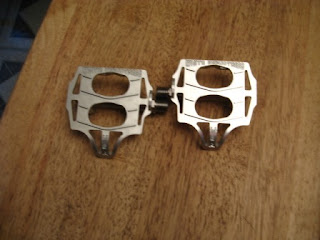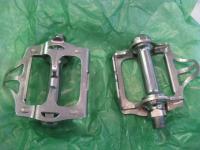It's the best design; it's an old design.
All right, now that I've got Dickens spinning in his grave, I'm going to tell you about two pedals that, in most ways, are very similar.
The designs of both pedals' bodies are based, to a large degree, on that of the Lyotard Berthet #23, one of the most popular pedals in the history of cycling.
Both have long, curved "tongues" that allow for easy entry and exit from toe clips and straps.
The "tongues" of both pedals lead to relatively wide flat surfaces that nonetheless allow for good grip with a wide variety of shoes.
Both pedals have sealed cartridge bearings that spin smoothly and require little, if any, maintenance.
Both are available in either silver or black.
A pair of either pedal weighs approximately the same: 300 grams, give or take.
I have ridden one of the pedals in question for nearly two years, while the others have been part of my daily commute for almost two months.
So, you want to know, what pedals am I talking about?
Well, the ones I've been riding for nearly two years are the White Industries Urban Platform pedal. The pedals I've been using on my rides to and from work are made by Mikashima (MKS) and are called--you guessed it--the Urban Platform pedal.
In one of my earliest posts, I wrote about the White Industries pedals. In the nearly two years since I wrote that post, I've scarcely thought about them at all. They run smoothly, are comfortable on long rides and, so far, I haven't had to clean, much less overhaul, them. Plus, the ones on Tosca (my Mercian fixie) and Arielle (my Mercian road bike) seem not to have been affected, at least functionally, by bumps, scrapes and a couple of tumbles.
The pair pictured in that post went on Arielle. Subsequent pairs found their way onto Tosca and Helene (my custom Miss Mercian) in that order. The pedal in this photo is on Helene:
The WI pedals on Arielle and Helene are silver; the ones on Tosca are black. While I liked the look of the black ones in the beginning (especially in how it offset the brass dustcap), I wouldn't buy them in black today, as the ones I have scuffed and scratched. The silver ones don't show such wear.
All in all, the White Industries pedals are among the finest components I have ever used. In their design and quality of materials and workmanship, they are (I believe) in the same class as Chris King headsets, Phil Wood hubs and bottom brackets, Mavic Open Pro rims and Nitto handlebars, stems and seatposts--all of which I have used for years.
Now, I can't speak for the durability my the MKS Urban Platform pedals, which I've been riding on Vera, the 1994 Mercian mixte I purchased last year. However, if they are anything like other MKS pedals I've used, they should provide me many years and miles of service--barring an accident, of course.
While the basic form of the MKS pedal is much like that of its White Industries counterpart, there are some subtle differences. There are more pronounced "ridges" on the MKS pedal, which one would expect to provide somewhat better grip. However, I haven't noticed any real difference in that area between the two pedals.
Also, on the WI pedal, the transition from the pedal body to the toeclip is smooth and flat. In contrast, the toe clip mounts slightly below the edge of the MKS Urban pedal, as it does on the GR-9, the other platform pedal MKS makes. I did not feel any discomfort as a result of it; then again, I have been used WI pedals on longer rides, and for a longer period of time, than I've used the MKS Urban.
The platform width of both pedals is about the same, and each is slightly wider than the Berthet and significantly wider than the GR-9.
Another difference is between the two pedals is that the MKS Urban has a one-piece cast body, while the platform of the WI is attached to a precision stainless-steel spindle with sealed bearings. What that means, in terms of aesthetics, is that while the two pedals look very similar from above, the MKS Urban looks more like the GR-9 from below, while the WI looks a bit more like the Berthet. What that means in terms of function, I don't know: They work in similar ways, and seem to have the same amount of ground clearance.
Perhaps the clearest difference between the pedals, apart from their appearance, is price: My MKS Urbans cost about half of what I paid for each pair of WI pedals I now ride. I got what was probably the lowest price available on my WIs from Universal Cycles of Portland, OR; coupons brought the price down even further. I purchased my MKS Urbans from Bell's Bike Shop of Philadelphia, which sells on eBay.
As happy as I am with my White Industries pedals, I might not have bought them had I known about the MKS Urban pedals, or had I not found the deals I got. Or, perhaps, I would have bought them for one, or possibly two, of my bikes. That is not to say, of course, that you shouldn't buy WI pedals, especially if you truly appreciate fine design and workmanship and/or can score a good deal. But for half of the price of the White Industries Urban pedal, you can get the MKS Urban Platform, which, in my estimation, is about 95 percent as good.
All right, now that I've got Dickens spinning in his grave, I'm going to tell you about two pedals that, in most ways, are very similar.
The designs of both pedals' bodies are based, to a large degree, on that of the Lyotard Berthet #23, one of the most popular pedals in the history of cycling.
Both have long, curved "tongues" that allow for easy entry and exit from toe clips and straps.
The "tongues" of both pedals lead to relatively wide flat surfaces that nonetheless allow for good grip with a wide variety of shoes.
Both pedals have sealed cartridge bearings that spin smoothly and require little, if any, maintenance.
Both are available in either silver or black.
A pair of either pedal weighs approximately the same: 300 grams, give or take.
I have ridden one of the pedals in question for nearly two years, while the others have been part of my daily commute for almost two months.
So, you want to know, what pedals am I talking about?
Well, the ones I've been riding for nearly two years are the White Industries Urban Platform pedal. The pedals I've been using on my rides to and from work are made by Mikashima (MKS) and are called--you guessed it--the Urban Platform pedal.
In one of my earliest posts, I wrote about the White Industries pedals. In the nearly two years since I wrote that post, I've scarcely thought about them at all. They run smoothly, are comfortable on long rides and, so far, I haven't had to clean, much less overhaul, them. Plus, the ones on Tosca (my Mercian fixie) and Arielle (my Mercian road bike) seem not to have been affected, at least functionally, by bumps, scrapes and a couple of tumbles.
The pair pictured in that post went on Arielle. Subsequent pairs found their way onto Tosca and Helene (my custom Miss Mercian) in that order. The pedal in this photo is on Helene:
 |
| White Indstries Urban Pedal |
The WI pedals on Arielle and Helene are silver; the ones on Tosca are black. While I liked the look of the black ones in the beginning (especially in how it offset the brass dustcap), I wouldn't buy them in black today, as the ones I have scuffed and scratched. The silver ones don't show such wear.
All in all, the White Industries pedals are among the finest components I have ever used. In their design and quality of materials and workmanship, they are (I believe) in the same class as Chris King headsets, Phil Wood hubs and bottom brackets, Mavic Open Pro rims and Nitto handlebars, stems and seatposts--all of which I have used for years.
| MKS Urban Platform Pedal |
Now, I can't speak for the durability my the MKS Urban Platform pedals, which I've been riding on Vera, the 1994 Mercian mixte I purchased last year. However, if they are anything like other MKS pedals I've used, they should provide me many years and miles of service--barring an accident, of course.
While the basic form of the MKS pedal is much like that of its White Industries counterpart, there are some subtle differences. There are more pronounced "ridges" on the MKS pedal, which one would expect to provide somewhat better grip. However, I haven't noticed any real difference in that area between the two pedals.
Also, on the WI pedal, the transition from the pedal body to the toeclip is smooth and flat. In contrast, the toe clip mounts slightly below the edge of the MKS Urban pedal, as it does on the GR-9, the other platform pedal MKS makes. I did not feel any discomfort as a result of it; then again, I have been used WI pedals on longer rides, and for a longer period of time, than I've used the MKS Urban.
The platform width of both pedals is about the same, and each is slightly wider than the Berthet and significantly wider than the GR-9.
Another difference is between the two pedals is that the MKS Urban has a one-piece cast body, while the platform of the WI is attached to a precision stainless-steel spindle with sealed bearings. What that means, in terms of aesthetics, is that while the two pedals look very similar from above, the MKS Urban looks more like the GR-9 from below, while the WI looks a bit more like the Berthet. What that means in terms of function, I don't know: They work in similar ways, and seem to have the same amount of ground clearance.
 |
| Underside of White Industries Urban Pedal |
Perhaps the clearest difference between the pedals, apart from their appearance, is price: My MKS Urbans cost about half of what I paid for each pair of WI pedals I now ride. I got what was probably the lowest price available on my WIs from Universal Cycles of Portland, OR; coupons brought the price down even further. I purchased my MKS Urbans from Bell's Bike Shop of Philadelphia, which sells on eBay.
 |
| Underside of MKS Urban Platform Peal |
As happy as I am with my White Industries pedals, I might not have bought them had I known about the MKS Urban pedals, or had I not found the deals I got. Or, perhaps, I would have bought them for one, or possibly two, of my bikes. That is not to say, of course, that you shouldn't buy WI pedals, especially if you truly appreciate fine design and workmanship and/or can score a good deal. But for half of the price of the White Industries Urban pedal, you can get the MKS Urban Platform, which, in my estimation, is about 95 percent as good.






